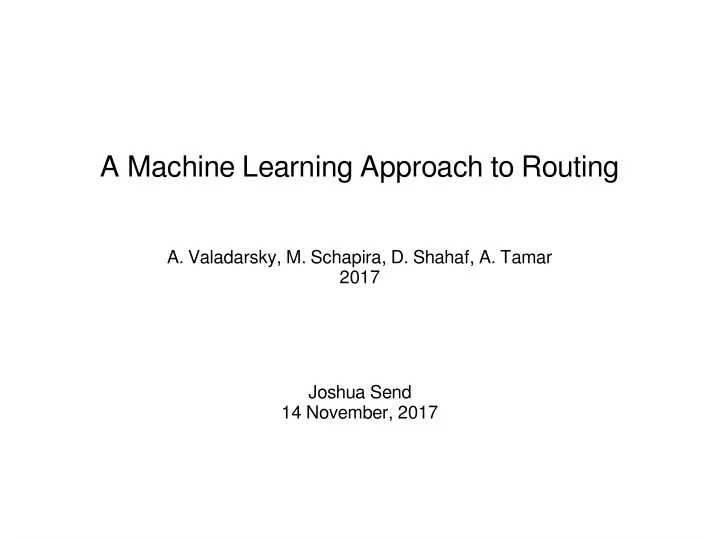

A Machine Learning Approach to Routing A. Valadarsky, M. Schapira, D. Shahaf, A. Tamar 2017 Joshua Send 14 November, 2017
Premise ● 2017 – ML still hasn't been properly explored for networking ● Goal: Preliminary work exploring ML for routing ● Lots of past work on flow optimisation – for given topology and traffic demands, optimal routing configurations can be computed ● Fail miserably in dynamic situations ● Given past traffic conditions, optimise with respect to them and hope it works well in the future ● Find a good (static) routing configuration for a range of traffic scenarios
High Level Questions ● Learn next input (“demand”) then calculate routing, or learn routing configuration directly? ● What should a learning algorithm produce? ● Will supervised learning work? ● Can we use reinforcement learning?
Model ● Goal: repeatedly select routing configuration minimizing congestion ● Model network as a directed graph where edge weights are link capacities ● Routing Strategy : for all source s and destination d pairs, at any vertex v , how traffic going from s to t through v is split across neighbors of v – |V| 2 * |E| variables overall – Require loop-free routing ● Demand Matrix: specifjes traffjc demand between all (source, destination) pairs
Stategies ● Given a demand matrix D , we can calculate an optimal routing strategy via linear programming ● Supervised Learning – Predict next demand matrix, given past D 's – Calculate routing strategy from result ● Reinforcement Learning – Learn routing strategy directly from sequence of last k D 's
Supervised Learning ● Assume regularity in network demand (daily, weekly cycles etc) ● Input: last k demand matrices, predict next D ● Various neural nets: fully connected; CNN; NAR-NN (nonlinear auto-regressive) ● Generate “actual” demand matrix sequences 1) Deterministically generated from prior D 's (cyclic of length q ) 2) Independently generated from fixed prob dist. ● Result: only NAR-NN succeeds for only cyclic scenario if q < k
Reinforcement Learning ● |V| 2 *|E| is too large ● Destination-based routing: each vertex splits traffic across neighbors based only on destination: |V|*|E| ● TRPO [4] learning on 3 layer, fully connected NN ● Reward = ( max-link-utilization / optimal-max-link-utilization) given the next real D ● Learn mapping from k past D 's to per-vertex traffic splitting ratios ( softmax (real output) → routing probabilities) ● Result: 700 epochs, still produces high max-link utilization ● Authors propose number of output parameters is too large
Reinforcement Learning – Softmin Routing ● Only learn 1 parameter per edge: |E| parameters ● Given parameters p , and vertex v , we can calculate edge weights via shortest-path intermediate step, then apply softmin to calculate splitting probabilities ● Reward same as before ● Compare to three baselines: softmin routing based directly on prior D , based on average of last D 's, and oblivious [3] (routing strategy independent of past D 's)
It works!
Discussion ● Claims to be a very early paper in ML applied to routing – Very broad, shallow analysis – Not much evaluation presented except for select cases – Try to cover a huge configuration space: different ways to generating individual demand matrices, sequences of matrices, neural net architectures, supervised/reinforcement... ● There have been starts at using learning in networking in the 90s [2] ● Only recently a few papers published with modern ML techniques
Discussion ● Could spawn lots of future work – Different types of networks (including less simplified models) – More training time, different architectures (RNN?) – Different supervised learning approaches ● Big Idea – ML has lots of potential for generating efficient, dynamic routing strategies
References 1)A. Valadarsky et al.: A Machine Learning Approach to Routing, arXiv, 2017. 2)Boyan, Justin A., and Michael L. Littman. "Packet routing in dynamically changing networks: A reinforcement learning approach." Advances in neural information processing systems. 1994. 3)Azar, Yossi, et al. "Optimal oblivious routing in polynomial time." Proceedings of the thirty-fifth annual ACM symposium on Theory of computing. ACM, 2003. 4)Schulman, John, et al. "Trust region policy optimization." Proceedings of the 32nd International Conference on Machine Learning (ICML-15). 2015.
Recommend
More recommend